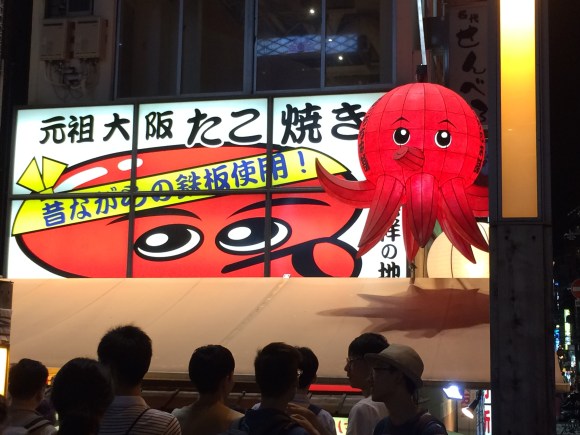
Osaka is famous for Osaka-style okonomiyaki as well as takoyaki. We’ve taught you all about okonomiyaki before, including how to make it at home, and we’ve taken you with us octopus hunting in the Seto Inland Sea where we showed you not only how to catch an octopus, but how to turn its head inside out. So it’s only natural that we feel you are ready to advance your octopial knowledge by exploring what happens to the eight-legged creatures after the catch. Welcome to the wonderful world of takoyaki, battered octopus balls!
Takoyaki is to Osaka what monjayaki is to Tokyo. There’s even a Takoyaki Museum just outside of Universal Studios Japan on the Universal City Walk, with a collection of food stalls where visitors can taste varieties of the snack as well as see the implements used to make it. And since this is Japan, you can also buy numerous takoyaki-inspired souvenirs.
Let’s delve into the delectable world of takoyaki together, after the jump.
The octopus-enhanced treat has its genesis in Osaka, a city that offers free WiFi for travelers and is home to an octopus-loving 2.6 million people. The city, which often seems like one large entertainment district with party-goers descending on the neon-splashed streets in droves, isn’t a part of any of Japan’s 43 prefectures, but instead calls itself a “fu,” or district. In its own right, Osaka has developed a reputation as a place to indulge in the extravagance of food, or more simply put, kuiadore in Japanese. Located on the Seto Inland Sea, Osaka Bay has always been a major port for domestic trading as well as providing a porthole to the Inland Sea from the Pacific. With so much commerce going through its doors, Osaka readily developed into a business-minded community.
So it’s not surprising that one enterprising street vendor, Tomekichi Endo who found himself sampling an akashiyaki treat in Hyogo Prefecture in 1935, hit on the idea to improve upon the dumpling and make a fortune. And he did. He still used octopus as an ingredient, but he changed the akashiyaki recipe from an egg-laced batter to that of a wheat-flour based batter. And wham—takoyaki was born!
▼Endo even used the same mold used to make akashiyaki.
All Endo needed now was octopus tentacles—lots of them! But since each of the sea creatures sports eight legs, and the Seto Inland Sea is a rich source of octopi, he had no problem providing the snack whose popularity expanded to other parts of Japan and spawned takoyaki stalls and restaurants throughout the archipelago.
Another thing that must have helped the popularity of takoyaki is the adaptability of cephalopod caricatures and their kawaii quotient. I mean, it would be a lot harder to sell people a treat based on wild boar hooves, right?
▼ This octopus has, apparently, already sacrificed three of his legs and the Japanese-style hachimaki around his head shows that he is working hard.
▼ You can even make light-up balloons out of octopus. Can’t do that with a wild boar. At least not without scaring everyone.
Another thing that makes takoyaki popular is that it is easy to eat. The bite-sized balls make it convenient to pick up with a toothpick.
▼ Little takoyakis, still in the mold, during the final stage of cooking.
Typically served together in a box, looking a bit like doughnut-holes, makes them portable so they can be taken on picnics, served at festivals, or eaten as regular street food.
▼ Included, on top of the box are wooden chopsticks and a packet of mayonnaise.
▼ The little morsel with a dollop of mayonnaise, looking yummy!
▼After a bite, we can see that they have not forgotten the tentacle. Whew!
Takoyaki is a comfort food for many Japanese people. Children love it, people hoe into it at festivals and with friends, and it’s even served at rest areas off the highway. These days many households have electric takoyaki molds for making the snacks at home.
If you haven’t tried this delightful treat yet, you’re really missing out on the flavor of Osaka. Watch this short video and see how it’s made, and I bet you won’t be able to pass up a takoyaki stall in Japan ever again!
There are many takoyaki stalls and restaurants in Osaka. Let our readers know if you have a favorite!
All images © Amy Chavez/RocketNews24

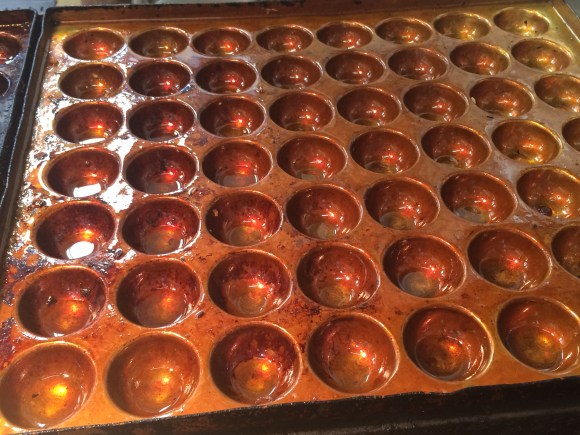
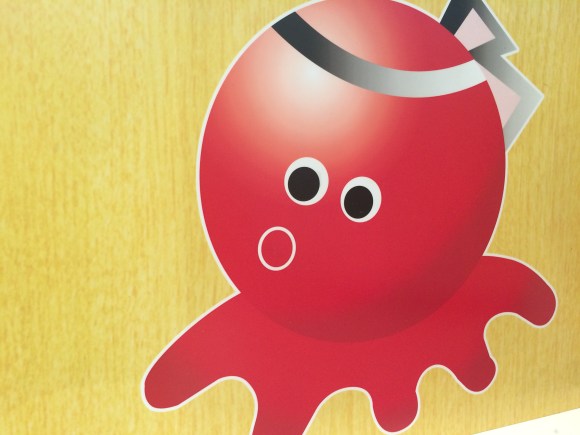
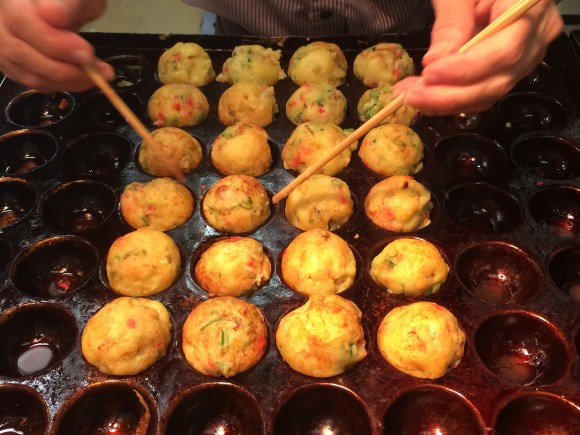
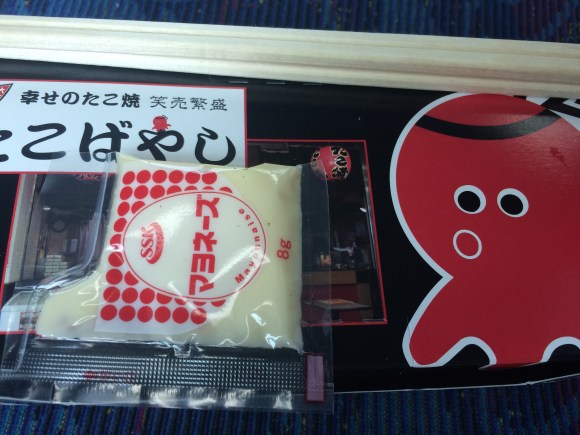
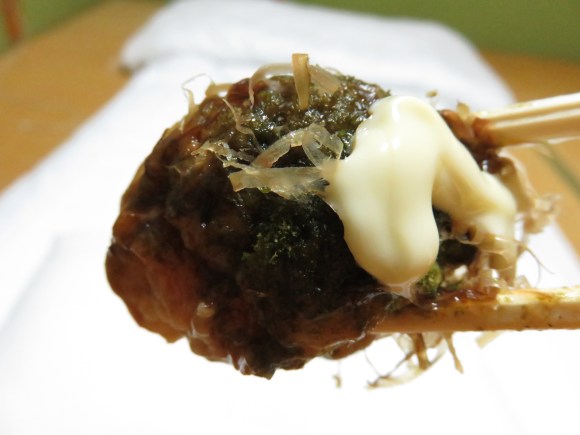
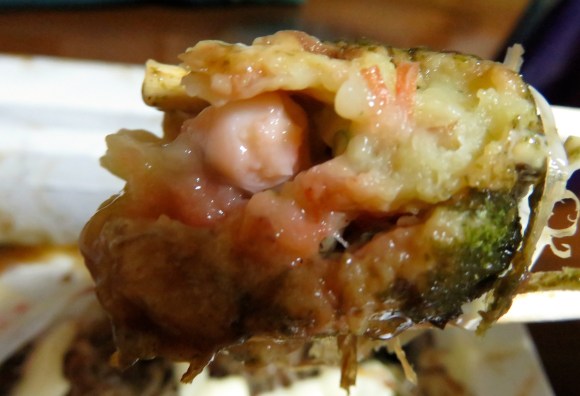
 Great balls of octopus and rice! It’s the Takoyaki Onigiri
Great balls of octopus and rice! It’s the Takoyaki Onigiri Octopus balls become octopus planets with amazing tweak to takoyaki recipe
Octopus balls become octopus planets with amazing tweak to takoyaki recipe We pig out at Aizuya, the Michelin Guide-featured takoyaki shop
We pig out at Aizuya, the Michelin Guide-featured takoyaki shop New cookbook turns the uni-tasker takoyaki maker into a versatile multi-tasker
New cookbook turns the uni-tasker takoyaki maker into a versatile multi-tasker Bizarre or brilliant? Takoyaki and okonomiyaki rice balls available in convenience stores now
Bizarre or brilliant? Takoyaki and okonomiyaki rice balls available in convenience stores now Foreigner’s request for help in Tokyo makes us sad for the state of society
Foreigner’s request for help in Tokyo makes us sad for the state of society Seaside scenery, history, and so many desserts on Yokohama’s Akai Kutsu【Japan Loop Buses】
Seaside scenery, history, and so many desserts on Yokohama’s Akai Kutsu【Japan Loop Buses】 Japanese city loses residents’ personal data, which was on paper being transported on a windy day
Japanese city loses residents’ personal data, which was on paper being transported on a windy day Japan’s summertime towelket pillowcases are even better with the addition of Ghibli stars【Photos】
Japan’s summertime towelket pillowcases are even better with the addition of Ghibli stars【Photos】 Osaka governor suggests lowering voting age to 0 to curb population decline
Osaka governor suggests lowering voting age to 0 to curb population decline Akihabara pop-up shop sells goods made by Japanese prison inmates
Akihabara pop-up shop sells goods made by Japanese prison inmates Red light district sushi restaurant in Tokyo shows us just how wrong we were about it
Red light district sushi restaurant in Tokyo shows us just how wrong we were about it 11 different ways to say “father” in Japanese
11 different ways to say “father” in Japanese Harajuku Station’s beautiful old wooden building is set to return, with a new complex around it
Harajuku Station’s beautiful old wooden building is set to return, with a new complex around it Historical figures get manga makeovers from artists of Spy x Family, My Hero Academia and more
Historical figures get manga makeovers from artists of Spy x Family, My Hero Academia and more McDonald’s new Happy Meals offer up cute and practical Sanrio lifestyle goods
McDonald’s new Happy Meals offer up cute and practical Sanrio lifestyle goods Japanese ramen restaurants under pressure from new yen banknotes
Japanese ramen restaurants under pressure from new yen banknotes French Fries Bread in Tokyo’s Shibuya becomes a hit on social media
French Fries Bread in Tokyo’s Shibuya becomes a hit on social media Studio Ghibli releases new action figures featuring Nausicaä of the Valley of the Wind characters
Studio Ghibli releases new action figures featuring Nausicaä of the Valley of the Wind characters New private rooms on Tokaido Shinkansen change the way we travel from Tokyo to Kyoto
New private rooms on Tokaido Shinkansen change the way we travel from Tokyo to Kyoto Tokyo Tsukiji fish market site to be redeveloped with 50,000-seat stadium, hotel, shopping center
Tokyo Tsukiji fish market site to be redeveloped with 50,000-seat stadium, hotel, shopping center Beautiful Ghibli sealing wax kits let you create accessories and elegant letter decorations【Pics】
Beautiful Ghibli sealing wax kits let you create accessories and elegant letter decorations【Pics】 Studio Ghibli releases Kiki’s Delivery Service chocolate cake pouches in Japan
Studio Ghibli releases Kiki’s Delivery Service chocolate cake pouches in Japan New definition of “Japanese whiskey” goes into effect to prevent fakes from fooling overseas buyers
New definition of “Japanese whiskey” goes into effect to prevent fakes from fooling overseas buyers Our Japanese reporter visits Costco in the U.S., finds super American and very Japanese things
Our Japanese reporter visits Costco in the U.S., finds super American and very Japanese things All-you-can-drink Starbucks and amazing views part of Tokyo’s new 170 meter-high sky lounge
All-you-can-drink Starbucks and amazing views part of Tokyo’s new 170 meter-high sky lounge More foreign tourists than ever before in history visited Japan last month
More foreign tourists than ever before in history visited Japan last month New Pokémon cakes let you eat your way through Pikachu and all the Eevee evolutions
New Pokémon cakes let you eat your way through Pikachu and all the Eevee evolutions Disney princesses get official manga makeovers for Manga Princess Cafe opening in Tokyo
Disney princesses get official manga makeovers for Manga Princess Cafe opening in Tokyo Sales of Japan’s most convenient train ticket/shopping payment cards suspended indefinitely
Sales of Japan’s most convenient train ticket/shopping payment cards suspended indefinitely Sold-out Studio Ghibli desktop humidifiers are back so Totoro can help you through the dry season
Sold-out Studio Ghibli desktop humidifiers are back so Totoro can help you through the dry season Japanese government to make first change to romanization spelling rules since the 1950s
Japanese government to make first change to romanization spelling rules since the 1950s Ghibli founders Toshio Suzuki and Hayao Miyazaki contribute to Japanese whisky Totoro label design
Ghibli founders Toshio Suzuki and Hayao Miyazaki contribute to Japanese whisky Totoro label design Doraemon found buried at sea as scene from 1993 anime becomes real life【Photos】
Doraemon found buried at sea as scene from 1993 anime becomes real life【Photos】 Tokyo’s most famous Starbucks is closed
Tokyo’s most famous Starbucks is closed One Piece characters’ nationalities revealed, but fans have mixed opinions
One Piece characters’ nationalities revealed, but fans have mixed opinions We asked a Uniqlo employee what four things we should buy and their suggestions didn’t disappoint
We asked a Uniqlo employee what four things we should buy and their suggestions didn’t disappoint Princesses, fruits, and blacksmiths: Study reveals the 30 most unusual family names in Japan
Princesses, fruits, and blacksmiths: Study reveals the 30 most unusual family names in Japan Survey finds that Osaka people don’t eat takoyaki octopus balls as much as you’d think
Survey finds that Osaka people don’t eat takoyaki octopus balls as much as you’d think New takoyaki gacha toys designed by a Japanese voice actress come with surprise fillings
New takoyaki gacha toys designed by a Japanese voice actress come with surprise fillings How to turn Cup Noodle instant ramen into delicious Osaka-style dumplings【SoraKitchen】
How to turn Cup Noodle instant ramen into delicious Osaka-style dumplings【SoraKitchen】 Osaka hotel has amazing all-you-can-eat takoyaki and kushikatsu breakfast buffet
Osaka hotel has amazing all-you-can-eat takoyaki and kushikatsu breakfast buffet Japan’s Uncle Fist loses money every week selling takoyaki to kids for just 10 yen, doesn’t care
Japan’s Uncle Fist loses money every week selling takoyaki to kids for just 10 yen, doesn’t care New Japanese takoyaki candy tastes so bad, even the makers doubted it would sell
New Japanese takoyaki candy tastes so bad, even the makers doubted it would sell Takoyaki store in Osaka becomes a hot topic on Reddit, but is it any good?
Takoyaki store in Osaka becomes a hot topic on Reddit, but is it any good? Eel-topped takoyaki is delicious in any season, but here’s why now is the best time to try it
Eel-topped takoyaki is delicious in any season, but here’s why now is the best time to try it Takoyaki store in Tsukiji serves up dried bonito flakes even bigger than the octopus balls
Takoyaki store in Tsukiji serves up dried bonito flakes even bigger than the octopus balls Is roughly half of Japan preconditioned to hate mint chocolate sweets?
Is roughly half of Japan preconditioned to hate mint chocolate sweets? Want to be popular with the ladies/men? Be good at making takoyaki, study says
Want to be popular with the ladies/men? Be good at making takoyaki, study says Black “Ninja Takoyaki” is Japan’s latest must-try cuisine from Osaka
Black “Ninja Takoyaki” is Japan’s latest must-try cuisine from Osaka We miss out on cheap all-you-can-eat takoyaki, but stuff ourselves with octopus balls anyway
We miss out on cheap all-you-can-eat takoyaki, but stuff ourselves with octopus balls anyway World’s first Takoyaki Guitar created in Japan, features a gas grill and octopus balls
World’s first Takoyaki Guitar created in Japan, features a gas grill and octopus balls
Leave a Reply